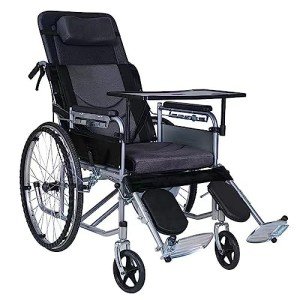Bariatric Wheelchair Seat Width
Seat Width

Having the proper seat width is very important to wheelchair users who invest longer periods in their chairs. Too narrow a seat will trigger pressure on the hips and thighs which might result in sores or pressure points. Having too large a seat can likewise make it hard for the user to reach the hand rims to propel themselves or maneuver in small areas.
To determine the proper seat width a person would rest on a chair normally and have their measurement taken across their lap at the widest point which is usually their hips. A wheelchair measuring tape can be used to determine this, but a lawn stick is chosen as it prevents people from wrapping the tape around their hips which would offer an incorrect result.
The standard wheelchair seat width is 16" (narrow grownup), 18" (standard grownup), and 20" (large grownup). For bariatric patients, a 24" seat is offered. This heavy-duty additional wide bariatric wheelchair from Medline includes swing-away footrests, a carbon steel frame with rust- and chip-resistant chrome plating, and easy-to-clean vinyl upholstery. It has a weight capacity of 500 pounds.
Seat Depth
Traditionally, the seat depth of a bariatric wheelchair was added 2" to the measurement taken at the user's best point (generally their hips). This was meant to accommodate extra layers of clothing that might be used during cold weather. Nevertheless, this practice is becoming less typical as wheelchair users are able to spend more time inside and are not wearing long coats. This makes the seat depth of a chair lesser when picking a bariatric wheelchair. Nevertheless, it is still crucial to select an alternative that offers sufficient assistance for bigger users.
The Medline folding additional large bariatric manual wheelchair includes a comfy 24" seat width and a heavy-duty slide tube silver vein frame. It also has an adjustable axle and tool-free elevating legrests.
Seat Height
When it concerns determining the correct wheelchair seat width you need to constantly measure from the user's best point which is generally their hips. You will also require to consider whether the user is going to be wearing a winter season coat as this may add 2" to the width needed.
When a wheelchair remains in use it must just be operated on level surface areas with the wheel locks fully engaged. This is to avoid the chair from having the ability to move inclines that are 10 degrees or higher. It is also crucial to remember that any activity that might shift the center of mass in the chair need to be done with care. This consists of grabbing items that require the individual to lean out of their seat or trying to stand up from it.
Whenever you have the chair in use it is suggested that you regularly check it for damage and lube any areas that are considered needed. For instance, the casters need to be lubricated by eliminating the caster fork and utilizing a multi-purpose grease to use to the caster stem bearings. Likewise, the foot plates can be changed by loosening up the bolt and then moving them to the preferred position. This enables the feet to sit easily on the footplate and prevents any pressure points from forming. This can be extremely uneasy for the user and if left unattended, can lead to push sores.
Weight Capacity
Bariatric wheelchairs are designed to support more weight than standard wheelchairs. This makes them tougher and much better geared up to deal with falls. They are likewise generally larger and larger, making them less maneuverable in tight spaces than basic wheelchairs. They require lorries with unique ramps and lifts to fill them, as well as motorists who understand how to best transport them from one location to the next.
When picking a wheelchair, consider its weight capacity as it will be the main determining consider whether it will accommodate your passenger's requirements. The weight capacity of the chair is typically noted as a fixed load, suggesting that it suggests the amount of weight the chair can easily hold while standing still. However, visit the up coming internet page list an active load that is based on a drop test and can simulate the result of somebody taking a seat in the chair. This may be a more trustworthy measurement of the weight limit, depending on your needs.
If you plan to carry out activities that move your center of mass in the seat (such as reaching for things), make certain to have front casters pointed in a forward instructions and wheel locks engaged so the chair will not topple. Likewise, inspect that casters are lubricated frequently to prevent extreme wear and abrasions. The lubrication treatment involves removing the fork, separating the caster from the wheel, and greasing the caster stem bearings with top quality multi-purpose grease.
